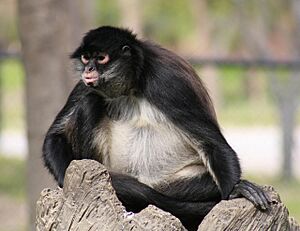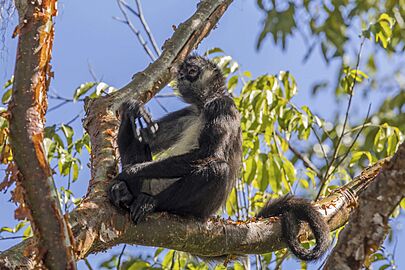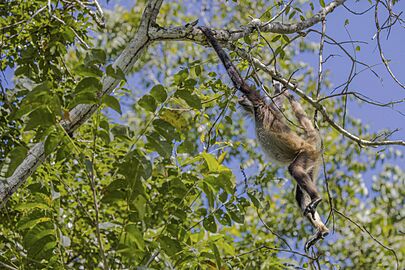Mexican spider monkey facts for kids
Quick facts for kids Mexican spider monkey |
|
|---|---|
 |
|
| At Miami MetroZoo, USA | |
| Conservation status | |
| Scientific classification |
|
| Kingdom: | Animalia |
| Phylum: | Chordata |
| Class: | Mammalia |
| Order: | Primates |
| Suborder: | Haplorhini |
| Infraorder: | Simiiformes |
| Family: | Atelidae |
| Genus: | Ateles |
| Species: | |
| Subspecies: |
A. g. vellerosus
|
| Trinomial name | |
| Ateles geoffroyi vellerosus (Gray, 1866)
|
|
The Mexican spider monkey (Ateles geoffroyi vellerosus), also called "Ma'ax" in Mayan, is a type of Geoffroy's spider monkey. It's one of the biggest New World monkeys. These monkeys live in the forests of Mexico, Guatemala, Belize, El Salvador, and Honduras. They are social animals, living in groups of 20 to 42 members. Since 2020, the IUCN Red List has listed this monkey as endangered. This means it faces a high risk of disappearing forever, mostly because of human activities.
The Yucatan spider monkey was once thought to be a different type. However, experts now say it's the same as the Mexican spider monkey.
These monkeys mostly eat fruit from trees. They are called frugivores. They plan their eating routes carefully and usually stay in areas they know. But big changes in their environment can affect what they eat and how they behave. In the wild, Mexican spider monkeys live for about 25 years. In zoos, they can live up to 35 years.
Contents
What Does the Mexican Spider Monkey Look Like?
The Mexican spider monkey weighs around 9 kilograms (about 20 pounds). This makes it one of the largest New World monkeys. It has long arms and a special tail called a prehensile tail. This tail is strong enough to hold the monkey's entire weight!
Their bodies are long and thin, covered with black fur. This fur often looks a bit messy. Adult monkeys are about 30 to 63 centimeters (12 to 25 inches) long. Their tails are even longer, from 63 to 84 centimeters (25 to 33 inches).
These monkeys live in tall fruit trees. They can swing up to 12 meters (40 feet) in one go! Because they move so much, they help spread seeds for many tree types. Monkeys from the Yucatan area often have slightly lighter fur. They usually have tan marks around their eyes and chin, and whiskers near their heads.
How Mexican Spider Monkeys Behave
Mexican spider monkeys are very social animals. They live in groups that can have anywhere from 10 to 100 members. On average, groups have 20 to 42 monkeys. Female monkeys usually lead these groups. One female often plans where the group will go to find food.
Male monkeys also form strong friendships. They show affection by grooming each other, hugging, and wrapping their arms around each other. The strongest bonds are often between males of similar ages. Older and younger males might also show affection, but it's often the younger male giving more respect to the older one.
These monkeys look for the tallest trees. These trees offer better protection from predators and more fruit. They usually eat early in the morning and rest for the rest of the day. If they feel threatened, they will "bark" loudly. They might also throw things like branches or even feces while jumping up and down.
Where Mexican Spider Monkeys Live
Mexican spider monkeys have a flexible way of living in groups. You might see a very large group of 10 to 100 monkeys together. However, it's more common to find smaller groups of 3 to 5 monkeys. They often split into smaller groups during the day to search for food. Then, they join back together later. This special social behavior is called fission-fusion.
Large groups tend to stay in forests they know well. Smaller groups might be found closer to human towns. Mexican spider monkeys prefer areas with lots of their favorite fruits. They also need good places to sleep and hide. Studies show they spend most of their time in areas between 3.1 and 9.2 hectares (about 7 to 23 acres). They like older forests with tall trees because these areas have more fruits and resources. Each year, they might explore new areas for food. But they usually prefer to stay in places they remember and know well.
Reproduction and Life Cycle
In the wild, Mexican spider monkeys live for about 25 years. In zoos, they can live up to 35 years. Female monkeys usually give birth every 2 to 3 years. This is because nursing a baby stops them from getting pregnant again too quickly. Their mating cycle lasts 24 to 27 days. When they mate, it lasts for two to three days. Pregnancy lasts a long time, about 226 to 232 days. Males are ready to have babies at five years old, and females at four years old.
Baby monkeys are born completely black. They cling to their mother's back for the first two years of their lives. They only start eating fruit when they are around two years old. Male spider monkeys do not help carry or raise the babies.
What Mexican Spider Monkeys Eat
The Mexican spider monkey is a frugivore, meaning it mostly eats fruit. About 90% of their diet is fruit. The other 10% can be eggs and insects. In zoos, they eat fruits, dog food, bread, and some vegetables like carrots and lettuce.
In the wild, their fruit diet changes based on what's available. But they prefer the most nutritious fruits. Their favorites include wild figs called "koochlé," ramón fruits, and other wild tamarind fruits. Leaves are also an important part of their diet, especially when there isn't much nutritious fruit around.
These monkeys move in straight lines toward their food. They can even find food areas they can't see from where they are. They always plan their foraging trips ahead of time. Their movement patterns are affected by the weather throughout the year. However, different seasons don't change how they move around.
After a big natural disaster, like a hurricane, they change their behavior. They split into smaller groups more often. They spend less time moving around. Also, their main food source changes from fruit to leaves.
Protecting Mexican Spider Monkeys
Since 2020, the Mexican spider monkey has been on the IUCN Red List as an endangered species. This means they face a very high risk of dying out in the next 45 years. Data from Global Forest Watch shows that cutting down forests is the main reason their numbers are dropping. This is happening in Mexico, El Salvador, Belize, Guatemala, and Honduras. If forests keep disappearing at this speed, the monkey's home could shrink by 40% in the next 40 years.
Human actions are a big problem for these monkeys. When their forest homes are broken up into smaller pieces, it makes them easier to hunt. Spider monkeys are often hunted for their meat or to be sold as pets. Farming animals, growing palm oil, and big projects like mining also destroy their homes. Also, female spider monkeys don't have babies very often. This makes it harder for their numbers to grow back, especially in areas where humans are causing problems.





